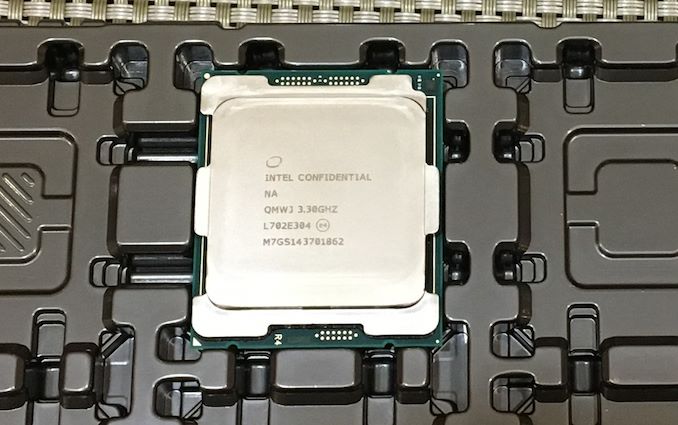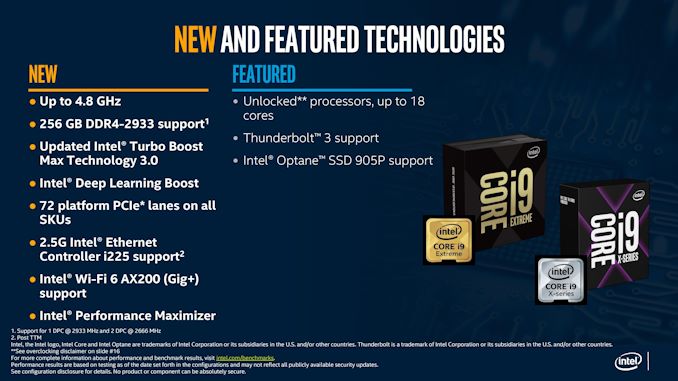Intel's Cascade Lake-X CPU for High-End Desktops: 18 cores for Under $1000
by Dr. Ian Cutress on October 1, 2019 6:35 PM EST- Posted in
- CPUs
- Intel
- HEDT
- LGA2066
- Cascade Lake

With someone in the press having broken their embargo earlier today, Intel is lifting the lid earlier than planned on their upcoming Cascade Lake-X family of processors for the high-end desktop (HEDT) market. Similar to the way Intel's Cascade Lake based Xeon Scalable processors are a further revision of their Skylake Xeons, offering clock speed increases and security fixes in hardware, the new HEDT processors will grant higher frequencies, more memory capacity, and better protection against side-channel attacks. The key numbers however are the big drop in Intel's pricing: Intel will be releasing its 18-core part, the Core i9-10980XE, for under $1000.
| Intel Cascade Lake-X | |||||||
| AnandTech | Cores Threads |
Base | All Core |
TB2 | TB3 | TDP | Price (1ku) |
| Core i9-10980XE | 18C / 36T | 3.0 | 3.8 | 4.6 | 4.8 | 165 W | $979 |
| Core i9-10940X | 14C / 28T | 3.3 | 4.1 | 4.6 | 4.8 | 165 W | $784 |
| Core i9-10920X | 12C / 24T | 3.5 | 4.3 | 4.6 | 4.8 | 165 W | $689 |
| Core i9-10900X | 10C / 20T | 3.7 | 4.3 | 4.5 | 4.7 | 165 W | $590 |
| Skylake-X (previous generation) | |||||||
| Core i9-9980XE | 18C / 36T | 3.0 | 4.5 | 4.7 | 165 W | $1979 | |
| Core i9-9940X | 14C / 28C | 3.3 | 4.5 | 165 W | $1387 | ||
| Core i9-9920X | 12C / 24T | 3.5 | 4.5 | 165 W | $1189 | ||
| Core i9-9900X | 10C / 20T | 3.5 | 4.5 | 165 W | $989 | ||
This pricing is a significant shift in Intel's strategy, and a number of fingers will be pointed at AMD as having made this happen. Next month AMD is set to launch its 16-core Ryzen 9 3950X at $749, which will offer 16 PCIe 4.0 lanes for slots (+4 for M.2, +4 for chipset) and support for 128 GB of DRAM. So Intel needed something similarly speedy, but with more PCIe lanes and more memory support that they could offer for just a bit more, leading to the 10980XE for $979. Ultimately, the on-shelf price is often just slightly higher than tray price, so don't be surprised if retail prices land at around $1000.
All the CPUs will support 256 GB of quad-channel memory (up from 128 GB), and have 48 PCIe 3.0 lanes (up from 44). Memory speed support is listed as DDR4-2933 for 1 DIMM per channel, and DDR4-2666 for 2 DIMMs per channel. All these CPUs have a TDP of 165 W, which Intel states will help the CPUs to turbo longer under Intel's recommended settings (as we know, consumer motherboard manufacturers like to ignore these anyway). All these CPUs are supported in X299 motherboards.
There is no 16-core in this stack, with Intel's official reasoning being that they assess the market with each generation and they don't believe there's a suitable price point for such a part when the 14C and 18C parts are so close. Most people will point the finger and say that no-16 core Intel part means no direct comparison with the Ryzen 9 3950X, which is something to think about.
Another point to note is that Intel has stopped this stack at the 10 core and no lower. This means that there will be no cross over between Intel's consumer processor stack and the HEDT stack, with users needing to spend just a little bit more from the Core i9-9900K/KF to reach up to the Core i9-10900X. It will be interesting to see where Intel's Core i9-9900KS fits in, although that still only has dual channel memory and 16 PCIe 3.0 lanes.
Intel lists Wi-Fi 6 and 2.5GbE support on these new processors - to clarify, Intel means external controllers here. For some odd reason when Intel says support, it could mean internal to the chipset or external via a controller; this is messaging I've railed against for a while, as it ends up confusing for enthusiasts, especially when this is an enthusiast platform. It does mean however that we get official information about Intel's 2.5GbE controllers, which we've been waiting on for a couple of years. Intel stated that these controllers will be ready at a later date, and more information to follow. (The controllers are currently listed on Intel's ARK database, but as 1 GbE controllers for some reason.)
These CPUs will have the same security mitigations as the Cascade Lake Xeon processors, with updated hardware mitigations for a number of side channel attacks. We are waiting to hear from Intel if the firmware that supports these processors will also have additional fixes in for Zombieload by default.
One question about this launch is surrounding Intel’s 14nm capacity. Within the last week, there have been reports that despite Intel’s best efforts and promises to match demand, and that Q3 and upcoming for Q4 is going to be busier than expected. We reached out to Intel last week for clarification, and the company said that the bulk of its capacity is focusing on the high-end processors in the market: the Xeon Scalable, the Core i9, Core i7, and Core i5. It will be interesting to see if launching another family of products is going to put additional strain on Intel’s capacity and demand.
With AMD's recent Zen 2 Ryzen 3000 series launch on 7nm earlier in the year, Threadripper 3 coming later this year, and Intel swinging another generation of 14++ into the high-end desktop market, Intel is going to have some tough times. Don't get me wrong, this pricing update from Intel is a good thing for users, especially those looking at implementing things like DL Boost to their workflow, but this market is suddenly turning very aggressive, and it will be interesting to see if Intel can be agile enough to keep pace.
Intel's Cascade Lake-X processors will be available in November. More details should be released nearer to launch.











162 Comments
View All Comments
bronan - Sunday, October 6, 2019 - link
Its a great time for those in need of many cores, for those who never use more than 4 cores/8 threads nothing has changed.
True many people can benefit from these monster products, but for a simple gamer it does not have any use at all. And i mean by that also that nothing released the last 2 years made me decide to buy any of the games which came out. Its kinda all old stuff in a new jacket.
And worse almost all of them force you to go online which i actually refuse todo.
I like strategy and once in a while i jump onto the good old games which where fun and did not annoy me to the edge of insanity.
And lets be honest the RTX hype which nvidia is trying to make is not goign to be a thing for many years to come. So as long as theirs hardly anything usefull todo with these rtx stuff i stay far away from it.
It just shows people are enormous happy when they got a new play-thing without a real function and can brag they got it.
Intel does jump on the same bandwagon now as well, and by that will make loads of people happy, especially those which actually make use of the many cores, like streamers and graphical folks.
The only reason why i am going to change my system in the coming 4 years is because its too limited in terms of available nvme slots and sata slots which i want to use.
I constant build new system images and rar and zip tons of files so you could say i could benefit from these monster cpu's as well. But actually i am not impressed my old 6700k still does it darn fast and this work needs much faster drives more than more threads.
If one could prove otherwise i would gladly look at the numbers but i am pretty sure that the premium price will not make up the tiny speed profit it makes.
We are so sucking into the latest hypes that we loose common sense is my opinion.
Sure both companies make impressive products but sadly AMD decided to screw customers who want to play games and did not release a lower core model with higher clocks instead they did the opposite. Which is totally bonkers i rather have a 4 core going much higher in clockspeed than a 16 core monster. But again AMD wants to make the most profit as Intel does and they choose to only give higher clocks on the most expenssive more core cpu's.
So no gains at all for normal players i was already stomped that this already old cpu does beat its replacing siblings in speed often. As long as we do not look at multi core performance.
So again no reason to switch till i really had enough of the limits of this mainbord.
GreenReaper - Sunday, October 6, 2019 - link
The thing about multiple cores is that nowadays there is relatively low cost to it; they can be turned off when not required. Because of this, it's no longer worth doing single-core CPUs at all. Most AMD dies are quad or even eight core. So... why sell a die as two or even four fast cores if they could sell it as four fast cores *and* four slower ones, unless there are flaws in the smaller one?The answer is, they don't. At least not until they have a bunch of flawed dies that *have* to be sold like that. Athlons are available, for example - and they have become relatively cheap compared to past dual-cores - but they are released late because there isn't the stock behind it before then.
Unfortunately flawed dies are often flawed in general and may not have any fast cores. *Some* of them might go faster but if there's only a few it may not make sense to make it a separate product.
If AMD were selling more chips you might see more specialist products. But think about what you are saying: you see value in those high-speed cores. So the price isn't likely to be *that* much smaller than that of a CPU with more cores, some of which go at a high speed. It's driven by value.
Your 6700K probably takes up a fair amount of power too. Something like a Ryzen 5 3600 will demolish it for power efficiency under a given load. This is something you may not care about, but others do. Again, it's probably not *that* much better for this purpose to have fewer cores because they can be turned off (indeed, it's often more efficient to "race to completion" and then turn off).